6 Hours with Ferrari in the Heat of the World Endurance Championship
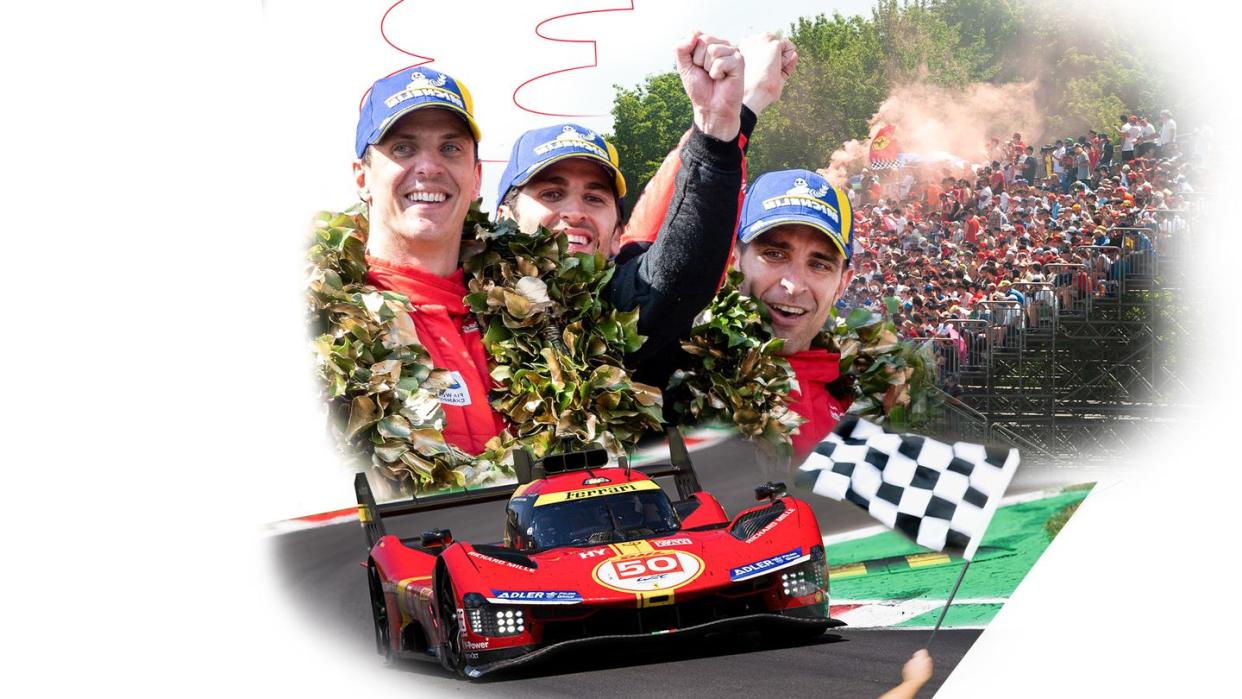
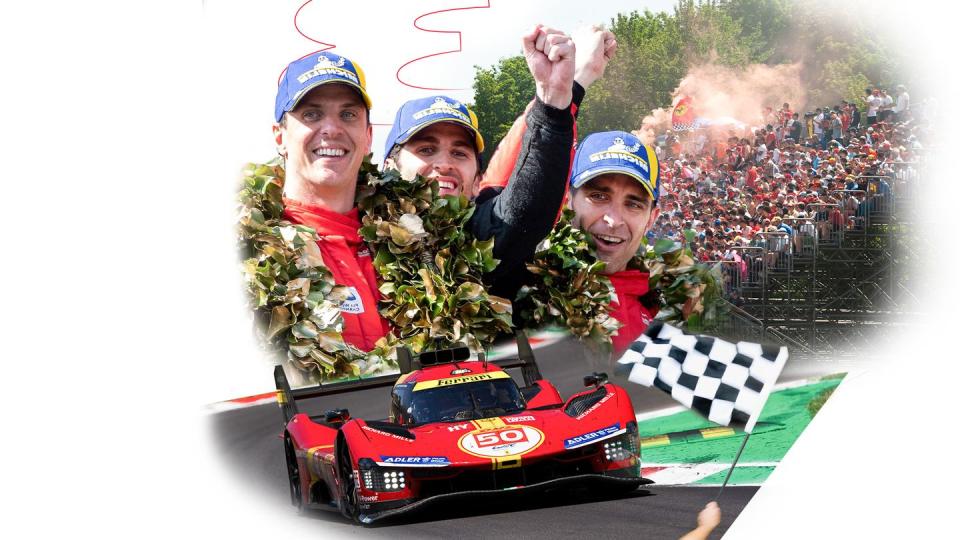
The g-force yanked my shoulder into the passenger-side door as we scraped and rumbled around one of the wicked turns at the Autodromo Nazionale di Monza. Then my sternum was wrenched the other way on the next one, towards the Ferrari 296’s center console where Alessandro Pier Guidi’s arm was resting serenely while his foot took us to upwards of 150 miles per hour. The 296 goes zero to sixty in 2.9 seconds, and we were going fast as soon as I realized we were going at all. My main concern before getting into a $342,000 sportscar with a professional race car driver was not that he would put us in danger but that I would by knocking into him. At one point, Pier Guidi looked over to me and cheerfully asked how I was enjoying the ride while we careened down the track. In fairness, he was attacking these corners with maybe 70 percent of the ferocity he would bring the next day, Sunday, race day.
The 39-year-old Pier Guidi is vastly experienced at high-octane levels, and he’s completed who-knows-how-many laps here at Monza, a track known as old school, “bumpy,” and more formally as “The Temple of Speed.” He would tack on upwards of 60 more laps the following day, when he ditched the 296 for Ferrari’s 499P, a hypercar that represents something close to the cutting edge of automotive technology. That was his contribution to a total of 199 laps the #51 car made, split between three drivers across the 6 Hours of Monza, the race that follows the legendary 24 Hours of Le Mans in the seven-event World Endurance Championship. The WEC flew us out to cover this next round in which Ferrari, competing in the top class of the endurance circuit for the first time in 50 years, looked to take a podium on essentially their home court. The massive and beautiful Parco di Monza, where you’ll find the autodromo, is a bit over two hours’ drive along the A1 motorway from the Ferrari base in Maranello, northern Italy.
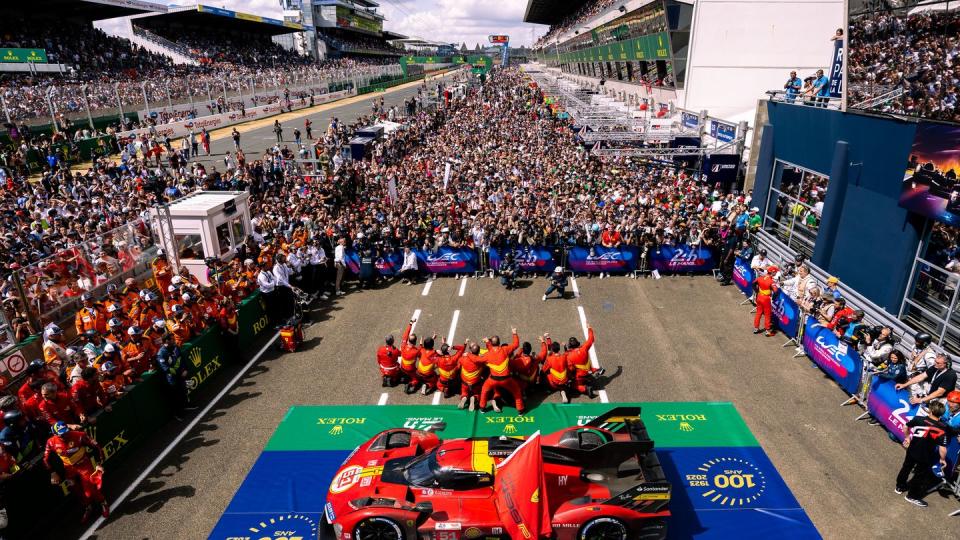
Scuderia Ferrari has struggled for form recently in Formula 1, a separate competition from the WEC, but victory here would be a back-to-back. The #51 car zipped past perennial endurance powers Toyota to win the 100th running of Le Mans last time out, Ferrari’s first victory on the famous French loop since 1965. It was greeted at Maranello by the other racing teams, factory staff, and around 5,000 assembled fans—sometimes known as tifosi—as a singular achievement for Ferrari in the modern era.
It was also a bit of sacrifice for James Calado, another member of the 51 team. He said he lost four kilos in water weight during Le Mans thanks to the almighty heat of the racecar. It was scorching in Monza during a heatwave that Italy’s Meteorological Society named “Cerberus” for the multi-headed dog that guards the entrance to the Underworld. The air was hot, the asphalt was hot, the tires were hot. “You’re sat in front of an engine and you’ve got two hot radiators in front of you as well,” Calado said. “And there’s only a bit of water in the car, less than a liter, which ends up being like a cup of tea after 10 minutes.” A wry 34-year-old Englishman who spent a lot of time in Italy growing up, Calado got his start as a kid racing motorbikes. But “I kept breaking my collarbones and arms and stuff,” he said, a British flag peeking out from the underside of the brim on his Ferrari hat. “My dad got a bit fed up and said, ‘Why don't we try some karting?’” That’s the usual starting point for European pros, from which they gradually move up the food chain of competitions until they break into the top levels.
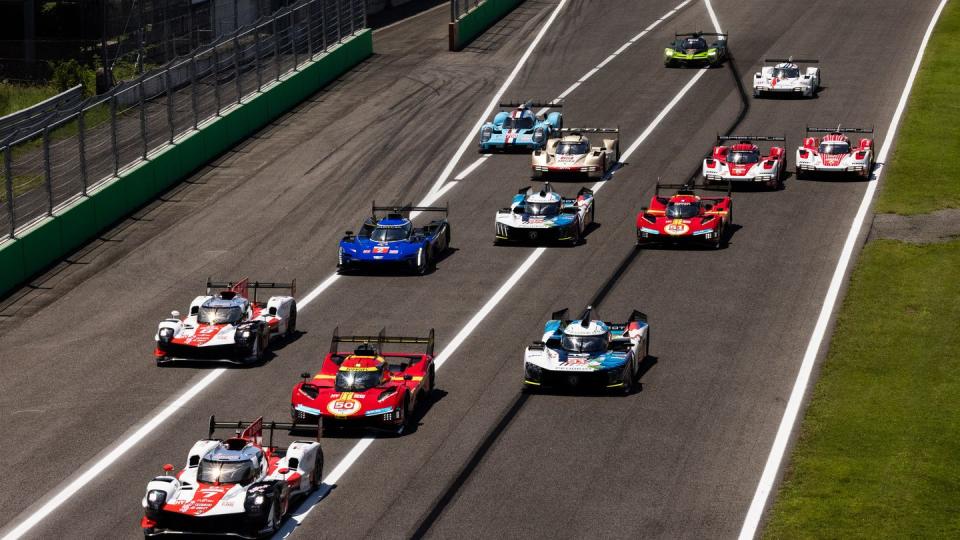
We were sat at a table on the second floor of Ferrari’s forward base in Monza, above a very red crowd at ground level outside. Athletes and their devotees intermix in the WEC race paddock in a way I’ve never really seen in sport, the drivers making their way from the garage to the pop-up HQ through spaces that are open to anyone who buys a paddock ticket. Mobs of admirers and autograph-seekers ensue. “Just to get from here to there takes ten minutes,” Calado said, gesturing beyond the throngs outside the window.
It’s red now, but there might be some yellow in there next year. Ferrari will be joined next season by their northern Italian neighbors, Lamborghini. (The two HQs—as well as Maserati’s—are located within 25 miles of each other around Modena, not far from the medieval stronghold of Bologna.) You can expect a vibrant following from younger fans with the Lambo’s rise as a meme achievement, a trophy purchase for people who get rich trading crypto and the like. BMW is joining up, too, and Porsche is already involved along with Cadillac and Peugeot. These are the big players among the nine manufacturers in hypercar, which is the top class above LMP2 (with its more standardized racing rigs to keep costs down) and GTE (supercars similar to those you occasionally see on the street, operated by a big manufacturer or a “gentleman driver,” a rich amateur who loves racing and often competes alongside pro teammates he hires). The three classes all race at once, and because the hypercars and LMP2s are significantly faster than the GTEs—and they all make so many laps of the track—passing becomes constant, crucial, and at times chaotic. If you played Mario Kart 64, it’s not unlike Toad’s Turnpike, and the WEC’s TV commentators will occasionally admit they don’t have a clue what just happened. On race day, the Ferrari 51 was bumped in a multi-car pileup on the very first turn and spun off the track.
Which didn’t end the day for Calado and company, because this is long-haul performance—driving fast laps for hours and hours, with plenty of time to change your situation. These races are long, a built-in obstacle for the WEC as far as packaging these events for TV, and they’re re-examining how to put together highlight packages and alternate coverage on YouTube. But for the folks who run the league, the long-haul formats are core to its identity, not any inherent problem.
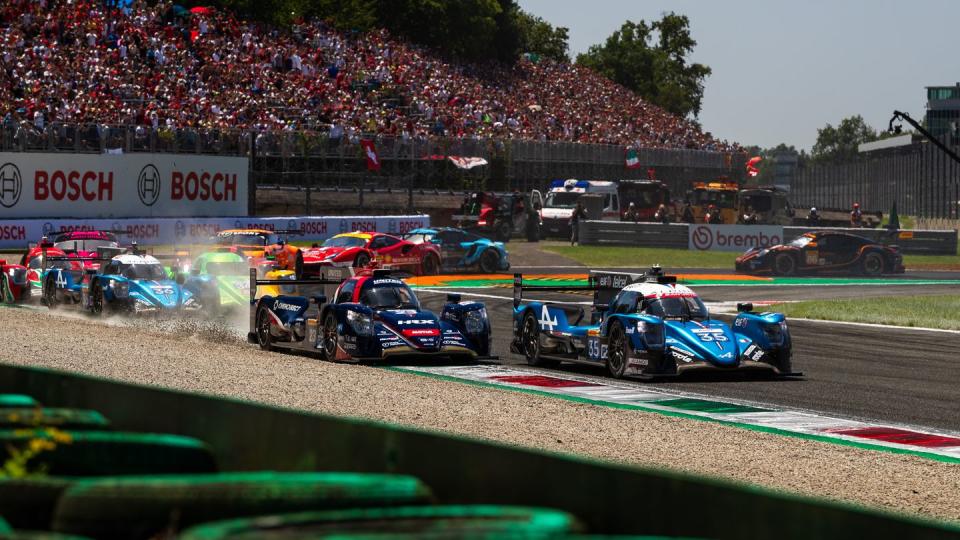
“You have sprint races that are always with the same winners, and you have endurance races, which are supposed to be boring, that are not,” said Richard Mille, one of the major figures in 21st-century watchmaking and a racing fanatic. He sponsors a GTE team and serves, at least when I sat down with him in an office above the track, as a kind of ambassador for endurance racing. “If you see the last Formula 1 race—of course, we don't want to say anything bad about Formula 1—but maybe you had a nap during that race,” he said over the sound of vintage cars whizzing by on the track outside, a bonus event for fans who’d showed up for qualifying day. You can believe he has no beef with F1, he says, because he also sponsors a team there. “If you saw the last Le Mans 24, you didn't have time to have a nap because until the last minute, until the last lap, it was so much suspense. Plus, of course, the rain. In Formula 1, when it rains, nobody races.”
The rain was not a problem on race day at Monza, or the day before. That’s when I sat down with my wheelman earlier in the day, Alessandro Pier Guidi, along with his teammate Antonio Giovinazzi. I watched the latter get mobbed by tifosi on his way to the Ferrari base. The 29-year-old Giovinazzi is a genuine star here on home soil following the win at Le Mans and a career in Formula 1 that never quite lived up to his immense promise as a young driver. When I asked if winning the 24 Hours had felt different, special, it was an easy yes. “First of all, the last victory for me was back in 2016,” he said, chuckling along with Pier Guidi. He’d just come in from a lukewarm qualifying, posting the sixth-best lap time and placing the 51 car behind the other Ferrari, the 50 car, which came second. “Giovi lost time in a good lap with a bit of traffic,” Pier Guidi said before his colleague arrived, meaning he’d gotten stuck in a cul de sac of cars and failed to best the pole-position time posted by Toyota’s Kamui Kobayashi. The top lap times from one to seven on the grid were packed in tight, however, with just.422 of a second between them. Pier Guidi said they had to be smart with their tires the next day in the blistering Monza heat, a glimpse of the equipment decisions and tactical calls these teams are making all day long. That includes when to pit, when to change drivers, and when to pass.
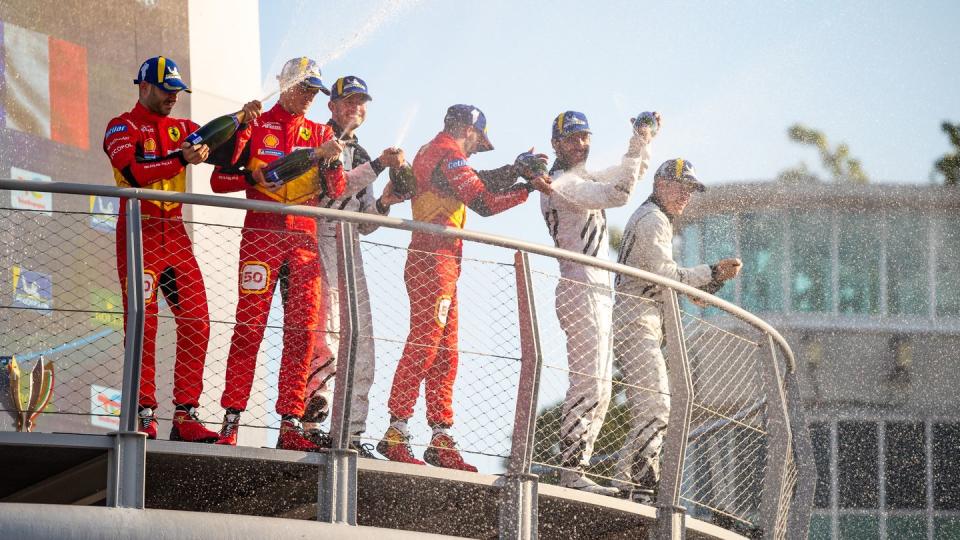
“When I raced in F1, sometimes you had a race without any overtakes,” Giovinazzi said. “Here, every lap you need to overtake five, six times, and the slower cars, you never know if they will give you enough space. It’s quite intense. You need to be focused 100% every lap.” That was what stuck out to me: this was moment-to-moment racing with all the demands of F1, maybe more, but it stretches on for hours. I asked the two Italians how you maintain that commitment to mental sharpness over such long periods. “Time is different inside the car,” Pier Guidi said. “Le Mans, I drove four hours, but the feeling was quite short. If you sit down at a table for four hours, you are destroyed. The reality inside the car is completely different. You try to optimize everything, push every lap, stay on the pace, and then the time flies.” The team goes into a race with a plan, but as conditions change—particularly at events like Le Mans and 6 Hours of Spa-Francorchamps, a favorite among many around this league—so do tactics. In the end, however, it’s all mostly instinct. When I asked how drivers at this level recover control when they’ve been bumped at speed, the two chuckled.
“I don’t know,” Pier Guidi said.
“It’s automatic,” Giovinazzi chimed in.
“If you think, you lost,” Pier Guidi added.
The following day, I stood on a platform above the divide between the pit lane and the track and watched the cars pull out of their diagonal parking jobs along the grid. They were getting into formation for a rolling start of the 6 Hours of Monza. The hypercars went first, revving into life at the front, followed by the LMP2s and the long line of GTEs towards the back. Once they were all in motion for the warmup lap, you could close your eyes and make out the varied and distinct sounds of different engines picking up speed. A whizz, a rip, a roar, a whoosh, a chainsaw buzz. There was the low guttural howl of the Cadillac, which has become a sonic feature of the WEC tour to rival the NASCAR rig that showed up for a one-off special assignment at Le Mans.
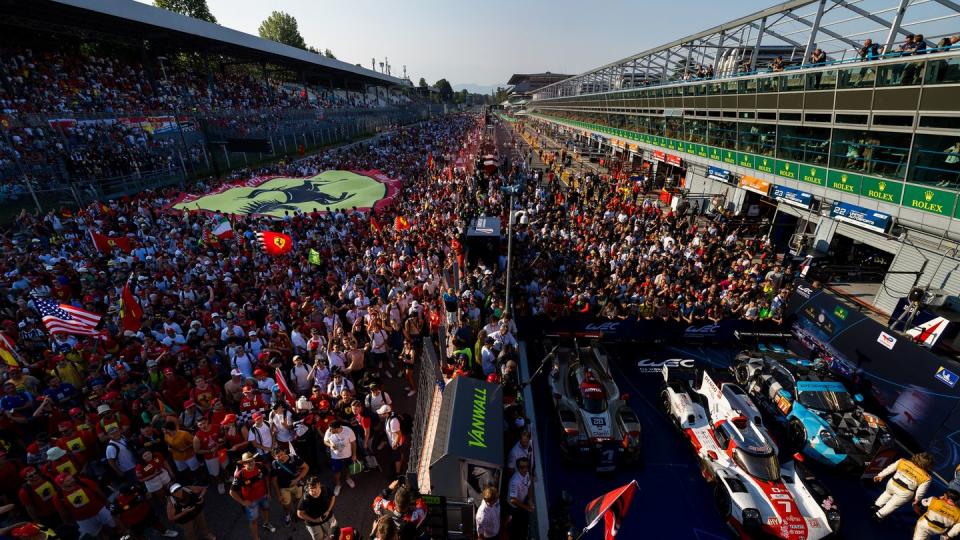
The big brands are attracted to hypercar for the opportunity to road-test innovative designs and advertise themselves as explorers in engineering. (Many of the automotive features we take for granted—windshield wipers, disc brakes—emerged from the shifting demands and conditions across 24 hours at Le Mans. Now the league is road-testing clean biofuels and has its eye on using hydrogen to power its cars by 2026.) On the grid before the race, you could walk amongst the hypercars and see the distinct silhouettes—the mantis-eye headlight frames of the light blue Glickenhaus, the Peugeot that operates sans spoiler—as an expression of each manufacturer’s identity, a testament to their style along with the substance under the hood. “Here you have cars that have real personality,” Richard Mille said, “and next year it will be even better.” The standardized LMP2s will be out, and the competition will move towards two classes—hypercar and the GTs—that allow the big shops and smaller garages to show off.
But as Mille tells it, they might also see it as an opportunity to be part of a particular kind of human drama. “You don’t have the clinical aspect that you [do] today in some disciplines,” Mille said, citing the closeness to the fans that drivers have here, a spirit that draws back to the days when everymen would drive at Le Mans. “You have real battles with a lot of human parameters, the team spirit, the strategy, the beauty of the cars.” He spoke of endurance racing as a kind of adventure test, something not wholly dissimilar to mountaineering, a measure of one’s strength of will and mentality and commitment along with the raw physical demands. “It’s only in endurance racing when you see people crying,” he said. The extraordinary demands—the sustained pressure of living micromoment to micromoment for hours on end—generate extraordinary stakes, along with a parade of Hollywood films. But rather than Ford v. Ferrari at Le Mans, this year it was Cadillac. The American outfit finished third behind the 51 car and the #8 Toyota.
In Monza, it was the #7 Toyota leading the field to start, followed by the #50 Ferrari. They got out ahead of the destruction at the first turn that sent Giovinazzi spinning in the 51 car, and they pretty much never looked back. The race length allowed the 51 to survive the opening setback, and a number of safety cars—which lead the racers through a multi-lap slowdown so crews can deal with wrecked vehicles on the track, kept things close throughout. Calado and Giovinazzi each overtook hypercar competition to move the 51 into fourth, but a late penalty saw them relegated to a fifth-place finish. After three days of sweltering heat and however many laps around this old-school fast track, the forces of chaos in endurance racing had cost them dear. It was still a good day for Ferrari, though: Antonio Fuoco, Miguel Molina, and Nicklas Nielsen guided the 50 car to second.
You Might Also Like


